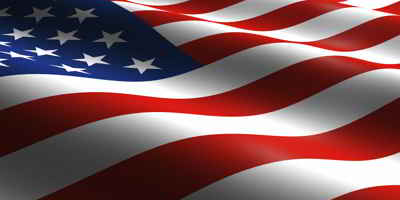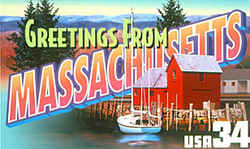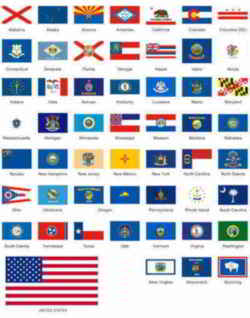

Massachusetts Symbols
Massachusetts
State Flag
Adopted in 1915; 1971.
On March 6, 1915, Massachusetts adopted a State flag that was very similar to the flag that flies over the Commonwealth today. The 1915 flag depicted the Commonwealth coat of arms on one side on a white field. On the other side was blue shield with a pine tree on it, a symbol of the value placed on wood by the settlers of Massachusetts.
Today, the design depicts the Massachusetts coat of arms on a white field on both sides of the flag, a design approved on June 2, 1971 to take effect on November 1, 1971.
The Massachusetts State Flag
The Commonwealth of Massachusetts' flag in the United States has been represented by official but limited-purpose flags since 1776, though until 1908 it had no state flag per se to represent its government. A variant of the white flag with blue seal was carried by each of the Massachusetts volunteer regiments during the Civil War alongside the National Colors. An exception were the two "Irish regiments" (the 9th and 28th Volunteers), each of which was permitted to carry an alternative green flag with a harp symbol. The state currently has three official flags: a state flag, a "naval and maritime flag" (despite it no longer having its own navy), and a governor's flag.
The Massachusetts State Flag is white, bearing on both sides a representation of the coat of arms (except that the five- pointed star is white instead of silver). In 1971, the flag was changed and only depicts the original front design and was adopted in its final form; before that, the obverse side depicted a pine tree. On a white field is a blue shield emblazoned with the image of a Native American , Massachusetts. He holds a bow in one hand and an arrow in the other. The arrow is pointing downward representing peace. The white star represents Massachusetts as one of the original thirteen states, the sixth state. Around the shield is a blue ribbon with the Massachusetts state motto: Ense Petit Placidam, Sub Libertate Quietem (" By the Sword We Seek Peace, but Peace Only Under Liberty".) Above the shield is the state military crest: the bent arm arm of Myles Standish with a broad sword blade up to remind that it was through the American Revolution that liberty was won, and representing the first part of the motto. The arm itself is the Goliad symbol common in early Texas flags and signifying the philosophy that those represented would rather lose their right arm than live under tyranny.
The first official nonmilitary state flag, which was adopted by the legislature on March 6, 1915, featured on the obverse side the coat of arms; on the reverse side was a green pine tree on a blue shield. In 1971 the reverse-side design was eliminated from the state flag, but the maritime flag (a pine tree on a plain white field) was resurrected.
Naval and maritime flag
In April 1776, the Massachusetts Navy adopted, as its flag (naval ensign), a white field
charged with a green pine tree and the motto "An Appeal to Heaven." In 1971 the motto
was removed, and the flag was designated "the naval and maritime flag of the Commonwealth".
Massachusetts is one of only two states with its own naval ensign (the other is Maine)
Massachusetts Flag Law
The General Laws of Massachusetts, Part 1, Title 1, Chapter 2
PART I. ADMINISTRATION OF THE GOVERNMENT.
TITLE I. JURISDICTION AND EMBLEMS OF THE COMMONWEALTH, THE GENERAL COURT, STATUTES AND PUBLIC
DOCUMENTS.
CHAPTER 2. ARMS, GREAT SEAL AND OTHER EMBLEMS OF THE COMMONWEALTH.
Chapter 2: Section 3. Commonwealth and naval and maritime flags; design
Section 3. The flag of the commonwealth shall consist of a white rectangular field, bearing
on either side a representation of the arms of the commonwealth, except that the star shall
be white. The naval and maritime flag of the commonwealth shall consist of a white rectangular
field bearing on either side a representation of a green pine tree.
Chapter 2: Section 4. Flag of governor; design
Section 4. The flag of the governor shall conform to the design of the flag of the commonwealth,
except that the field of the flag of the governor shall be triangular in shape.
Chapter 2: Section 5. Coat of arms, seal and flags of commonwealth; state secretary
as custodian; conformance to specifications; use and display regulations
Section 5. The state secretary shall be the custodian of the coat of arms, seal and flags of
the commonwealth and all representations of said arms, seal and flags shall conform strictly
to the specifications which shall be prepared under the direction of the state secretary in
the year nineteen hundred and seventy-one and deposited in his office. The proper use and display
of said arms, seal and flags of the commonwealth and their manufacture are hereby subject to
such regulations relating thereto which the state secretary may from time to time issue, provided
that such regulations shall be in conformity with all the relevant legislation of the United
States and of the commonwealth.
Chapter 2: Section 6. Flags of the United States and commonwealth; display
Section 6. The flag of the United States and the flag of the commonwealth shall be displayed
on the main or administration building of each public institution of the commonwealth. The
flags shall be of suitable dimensions and shall be flown every day when the weather permits.
Chapter 2: Section 6A. Commonwealth flag; flying at half-staff
Section 6A. The flag of the commonwealth shall be flown at half-staff at or on the main or
administration building of each public institution of the commonwealth, at or on each other
state-owned or state-controlled building, and at all state military installations on the following
occasions for the periods indicated:--
(a) On all occasions upon which the national flag is flown at half-staff and for the same period
of time;
(b) On the death of a governor or ex-governor of the commonwealth for thirty days from the
day of death;
(c) On the death of a lieutenant-governor, secretary, treasurer and receiver-general, attorney
general, or auditor of the commonwealth, from the day of death until sunset of the day of interment;
(d) On the death of a senator in congress from the commonwealth, from the day of death until
sunset of the day of interment;
(e) On the death of a representative in congress from the commonwealth, the flag of the commonwealth
shall be flown at half-staff at the aforementioned sites in the representative's congressional
district from the day of death until sunset of the day of interment;
(e1/2) On the death of a member of the general court, the flag of the commonwealth shall be
flown at half-staff from the day of death until sunset of the day of interment at the aforementioned
sites in the member's representative district on the death of a member of the house of representatives,
and the member's senatorial district on the death of a member of the senate.
(e3/4) On the death of a former member of the general court, the flag of the commonwealth shall
be flown at half-staff from the day of death until sunset of the day of interment in accordance
with such orders or instructions as may be issued by or at the direction of the governor after
consultation with the speaker of the house of representatives on the death of a former representative
in the general court, or with the president of the senate, on the death of a former state senator.
(f) In the event of the death of other elected officials or former elected officials of the
commonwealth, from the day of death until sunset of the day of interment in accordance with
such orders or instructions as may be issued by or at the direction of the governor; and
(g) In the event two or more of the aforementioned periods coincide in full or in part, the
state flag shall be displayed at half-staff for such period as will comply with the above provisions
without resulting in an additional and separate period of such display for each such death.

The Flags of the US.





